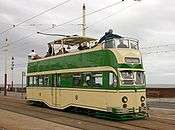Maley & Taunton

Open-topped Balloon tram 706 "Princess Alice" at Bispham, running on Maley & Taunton trucks.[1]
Maley & Taunton is a defunct tram and tramway engineering company. It was situated in Wednesfield in Staffordshire, England.[2] The principals, Alfred Walter Maley and Edmund MacKenzie Taunton (b 1884)[3] held patents for Tram and tramway machinery and equipment.[4][5] The company exported globally, with its trucks used in the Lisbon trams,[6] and locally — to the Blackpool tramway[1][7] and the Manx Electric Railway.[8]
Notes
- 1 2 "Hall of Fame: Blackpool Open-Top Balloon 706". British Trams Online. Retrieved 2007-12-04.
706 was originally one of a batch of 7 open-top trams delivered from English Electric in Preston to Blackpool for entry into service during September 1934, as part of the initial follow on order to the prototype streamlined trams unveiled previously.
- ↑ "Business records held at National Tramway Museum". National Register of Archives. Retrieved 2007-12-04.
- ↑ "Taunton of Wrackleford". Retrieved 2007-12-04.
- ↑ "Canadian Patents Database - Patent CA 352087 - Electrically Driven vehicle". Canadian Intellectual Property Office. Retrieved 2007-12-04.
- ↑ "Improvements in tramcars GB Patent GB442620". 1935. Retrieved 2007-12-04.
Abstract of GB442620 442,620. Tramcars; undercarriages. MALEY, A. W., 4, Grosvenor Road, Handsworth, and TAUNTON, E. M., 90, Fitz Roy Avenue, Harborne, both in Birmingham. Dec. 7, 1934, No. 35237. [Classes 103 (iv) and 103 (vi)] In a four-wheeled tram-car having a central side entrance, provision is made for accommodating a step outside the truck frame by insetting the longitudinal members of the latter at the parts 11, Fig. 1, between the axles 5. In conjunction therewith the side members 12 of the body underframe are dropped in the centre and reinforced against stresses by means of an elongated U-shaped member 13, Fig. 2, which also drops below the step and by a frame member 18 connected to the side members 12 and running behind the step. In a modification, Fig. 3, the member 13 is replaced by an angle bar 16 forming a rectangular loop that extends around the entrance and supports the step 17, truss plates 15 extending between the angle bar 16 and the longitudinals 14. The springing arrangement preferably includes leaf springs 9 and helical springs 10 interposed between the ends of the truck frame and the underframe, and helical springs 6 bearing upon spring beams 7 slung from the axleboxes 8.
- ↑ "Lisbon Trams, Part Two: Trams of The Past". Retrieved 2007-12-04.
#736-745 were 4 wheelers, built in 1947 and based on post-War German designs, on Maley & Taunton trucks with two 45hp motors. (et al.)
- ↑ "Hall of Fame: Blackpool Coronation 304". British Trams Online. Retrieved 2007-12-04.
Blackpool Coronation 304 joins the Hall of Fame on the back of its TV stardom on Channel 4's Salvage Squad program broadcast in the UK on 17 February 2003. 304 was the first Coronation tram of the fleet and arrived in the resort on 5 June 1952 having cost £10,000 and quickly started testing before the tram was officially unveiled to the public on 16 June, 3 days after the Ministry of Transport had inspected and passed the tram for public use.
- ↑ Goodwin, A M. "Is This Any Way To Run A Railway? The Story of the Manx Electric Railway Since 1956.". Retrieved 2007-12-04.
These bogie trucks, built in 1952, were available at £100 per pair and the rebuilding scheme was also agreed by the original manufacturers Maley & Taunton Ltd., of Wolverhampton who were prepared to produce the new components required for the regauging and rebuilding, despite the very small batch number involved.
| Wikimedia Commons has media related to Maley & Taunton streetcars. |
This article is issued from Wikipedia - version of the 1/13/2015. The text is available under the Creative Commons Attribution/Share Alike but additional terms may apply for the media files.
